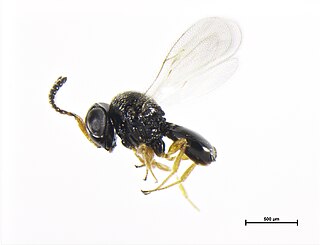
The chorion is the outermost fetal membrane around the embryo in mammals, birds and reptiles. It develops from an outer fold on the surface of the yolk sac, which lies outside the zona pellucida, known as the vitelline membrane in other animals. In insects it is developed by the follicle cells while the egg is in the ovary.

The choroid, also known as the choroidea or choroid coat, is the vascular layer of the eye, containing connective tissues, and lying between the retina and the sclera. The human choroid is thickest at the far extreme rear of the eye, while in the outlying areas it narrows to 0.1 mm. The choroid provides oxygen and nourishment to the outer layers of the retina. Along with the ciliary body and iris, the choroid forms the uveal tract.

The decidua is the modified mucosal lining of the uterus known as the endometrium that forms in preparation for pregnancy. It is formed in a process called decidualization under the influence of progesterone. Endometrial cells become highly characteristic. The decidua forms the maternal part of the placenta and remains for the duration of the pregnancy. It is shed off during childbirth — hence why the term is used, "decidua" having the meaning of falling away, as in the word deciduous.

The basal forebrain structures are located in the forebrain to the front of and below the striatum. They include the ventral basal ganglia, nucleus basalis, diagonal band of Broca, substantia innominata, and the medial septal nucleus. These structures are important in the production of acetylcholine, which is then distributed widely throughout the brain. The basal forebrain is considered to be the major cholinergic output of the central nervous system (CNS) centred on the output of the nucleus basalis. The presence of non-cholinergic neurons projecting to the cortex have been found to act with the cholinergic neurons to dynamically modulate activity in the cortex.

Cran's bully is a species of fish in the family Eleotridae endemic to New Zealand, where it is only found in fresh waters. This species can reach a length of 9 cm (3.5 in).

Coreopsis basalis is a North American plant species in the sunflower family. It is native to the southeastern and south-central United States from Texas to the Carolinas. Isolated populations have been reported from Connecticut, Illinois, and California.

Rhombodera basalis is a species of praying mantis of the genus Rhombodera. Its commons name is the giant Asian shield mantis. This insect has been known to grow up 120mm in captivity.

Milionia basalis is a moth of the family Geometridae first described by Francis Walker in 1854. It is found in Japan, the north-eastern parts of the Himalayas, Myanmar and Sundaland.

The nucleus basalis, also known as the nucleus basalis of Meynert or nucleus basalis magnocellularis, is a group of neurons located mainly in the substantia innominata of the basal forebrain. Most neurons of the nucleus basalis are rich in the neurotransmitter acetylcholine, and they have widespread projections to the neocortex and other brain structures.

Orthops basalis is a species of plant bugs belonging to the family Miridae, subfamily Mirinae that can be found everywhere in Europe except for Azores, Bosnia and Herzegovina Faroe Islands, Iceland and Cyprus.
Parastathes is a genus of longhorn beetles of the subfamily Lamiinae.
Parastathes apicalis is a species of beetle in the family Cerambycidae. It was described by Per Olof Christopher Aurivillius in 1925 and is known from Borneo.
Parastathes flavicans is a species of beetle in the family Cerambycidae. It was described by Gahan in 1907.
Parastathes moultoni is a species of beetle in the family Cerambycidae. It was described by Per Olof Christopher Aurivillius in 1914 and is known from Borneo.
Frea basalis is a species of beetle in the family Cerambycidae. It was described by Jordan in 1894. It is known from Cameroon, Angola, and the Democratic Republic of the Congo.
Glenea basalis is a species of beetle in the family Cerambycidae. It was described by James Thomson in 1865.
Nupserha basalis is a species of beetle in the family Cerambycidae. It was described by Erichson in 1843. It has a wide distribution in Africa.

Hylaeus basalis, the cinquefoil masked bee, is a species of hymenopteran in the family Colletidae. It is found in North America.

Marathyssa basalis, the light marathyssa, is a species of owlet moths, etc. in the family Euteliidae. It is found in North America.

Trissolcus basalis, or the green vegetable bug egg parasitoid, is a parasitoid wasp in the family Scelionidae known primarily for parasitising the horticultural pest Nezara viridula, the green vegetable bug. Like other species of Trissolcus, it is small, mostly black in colour, and females have clubbed antennae.













